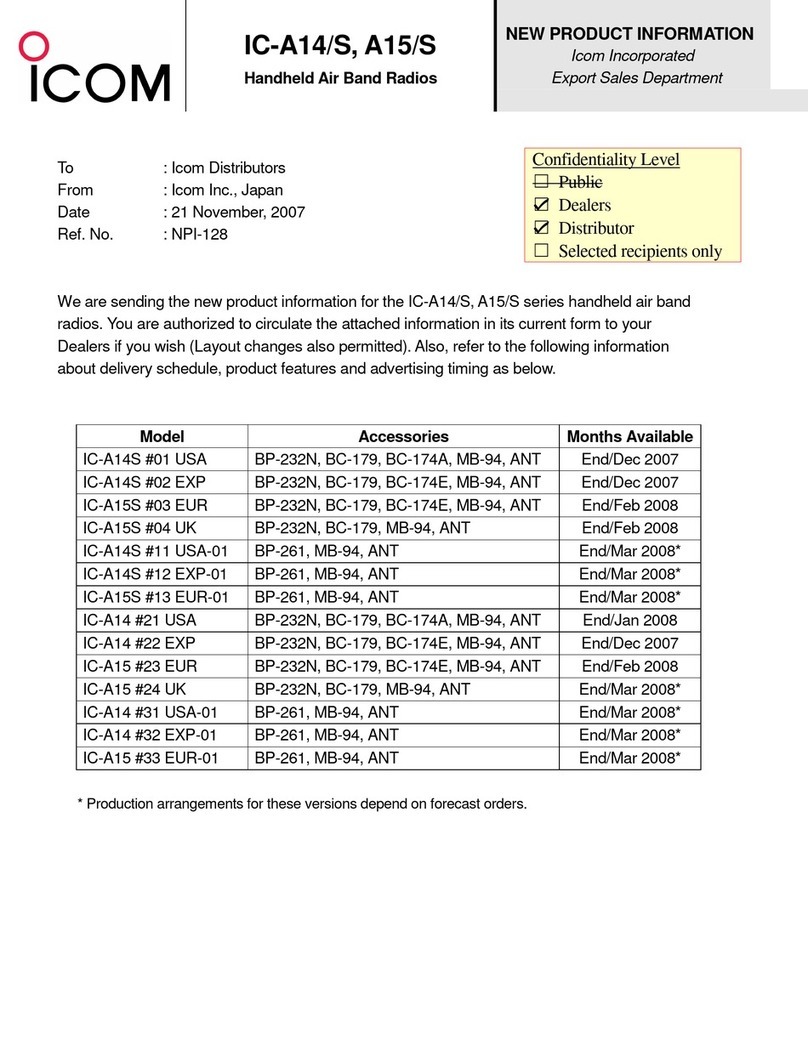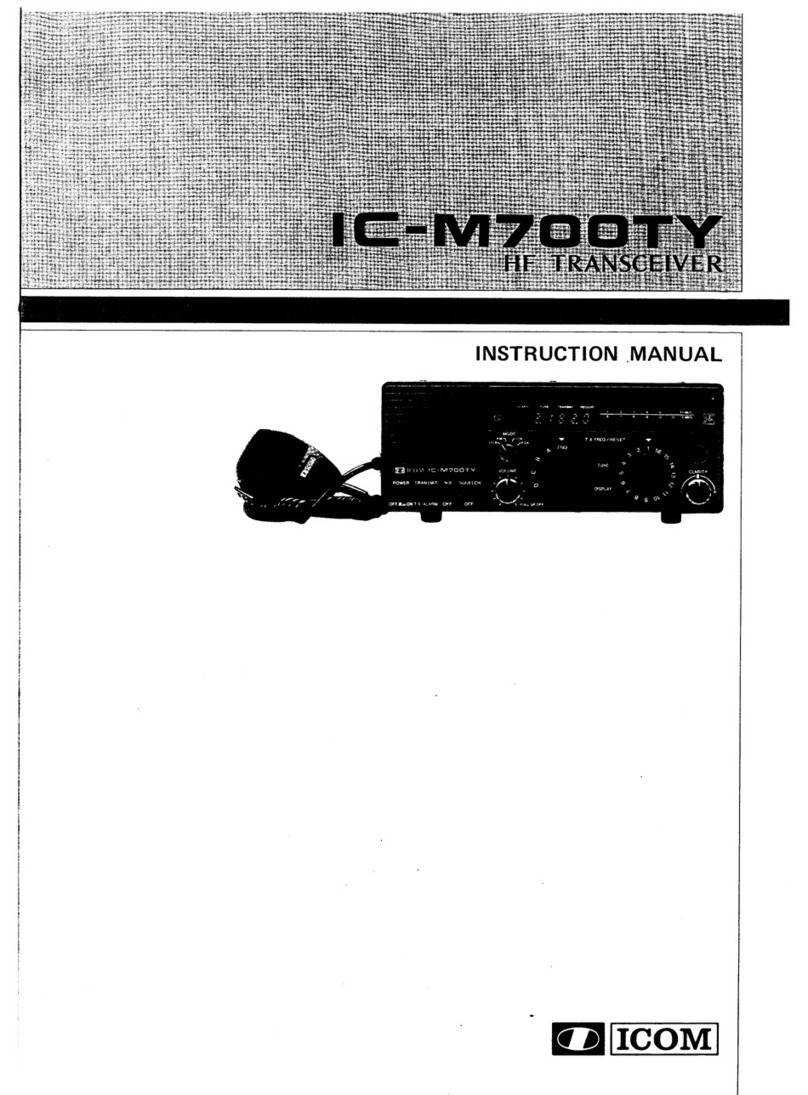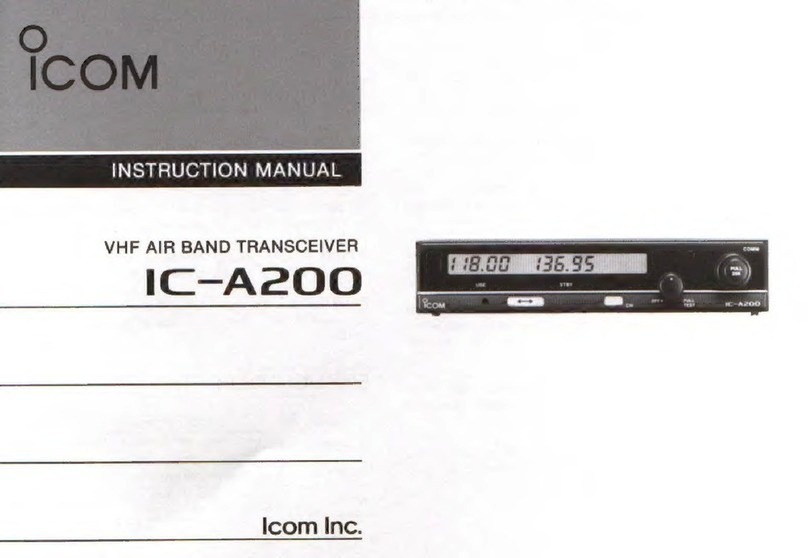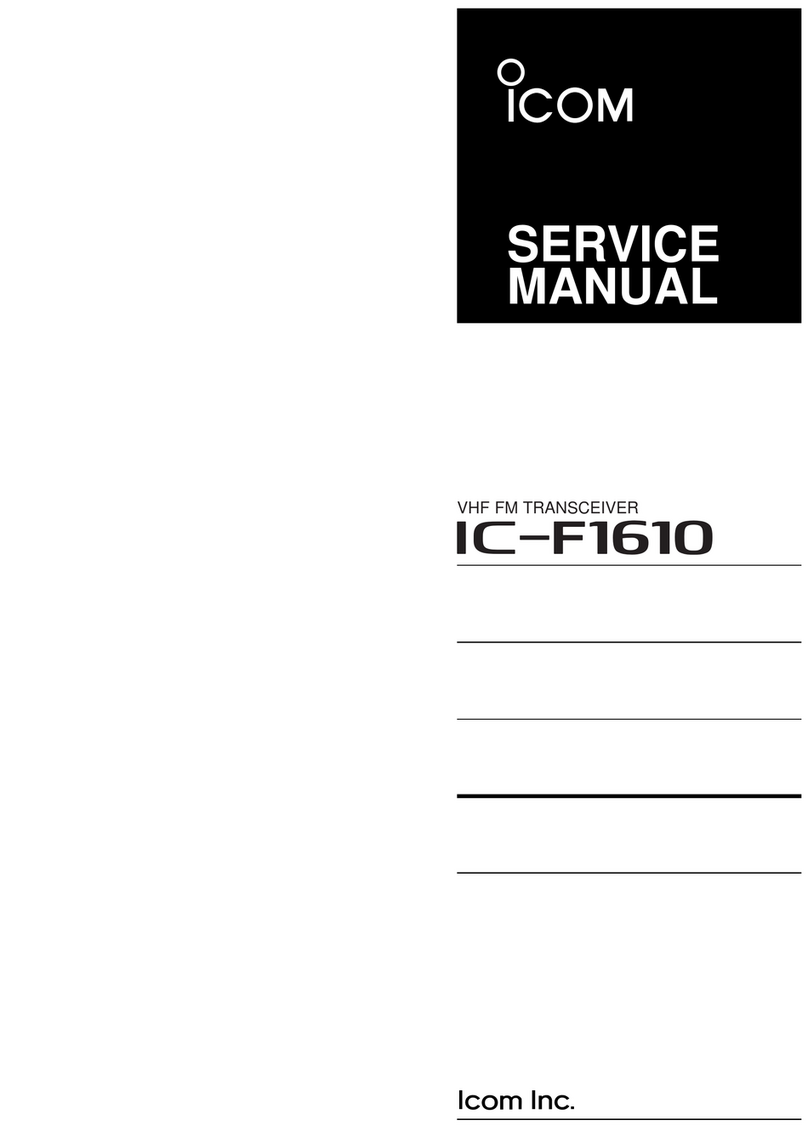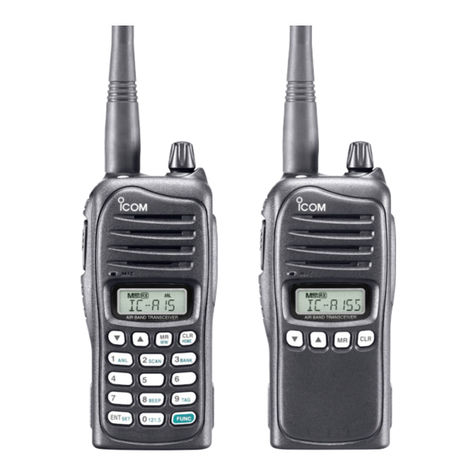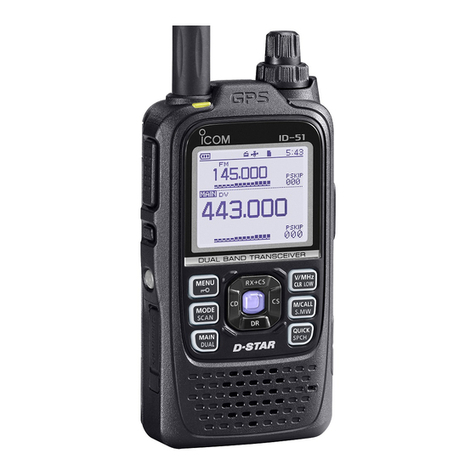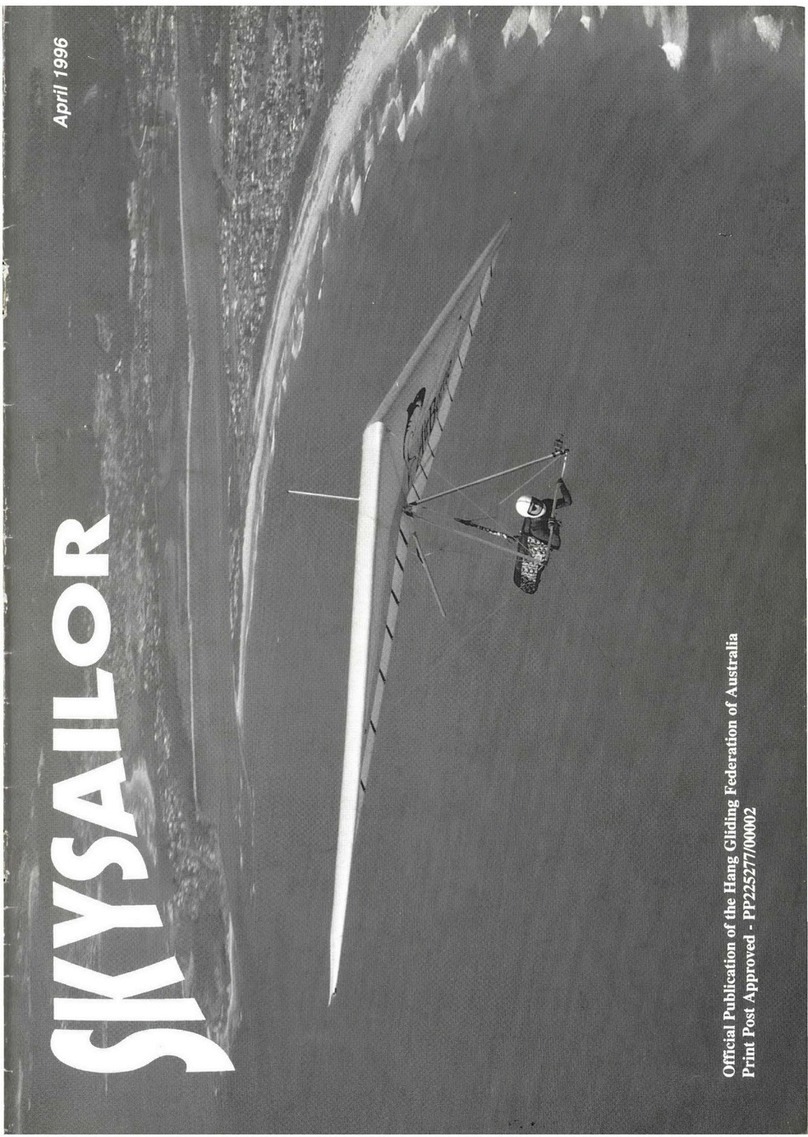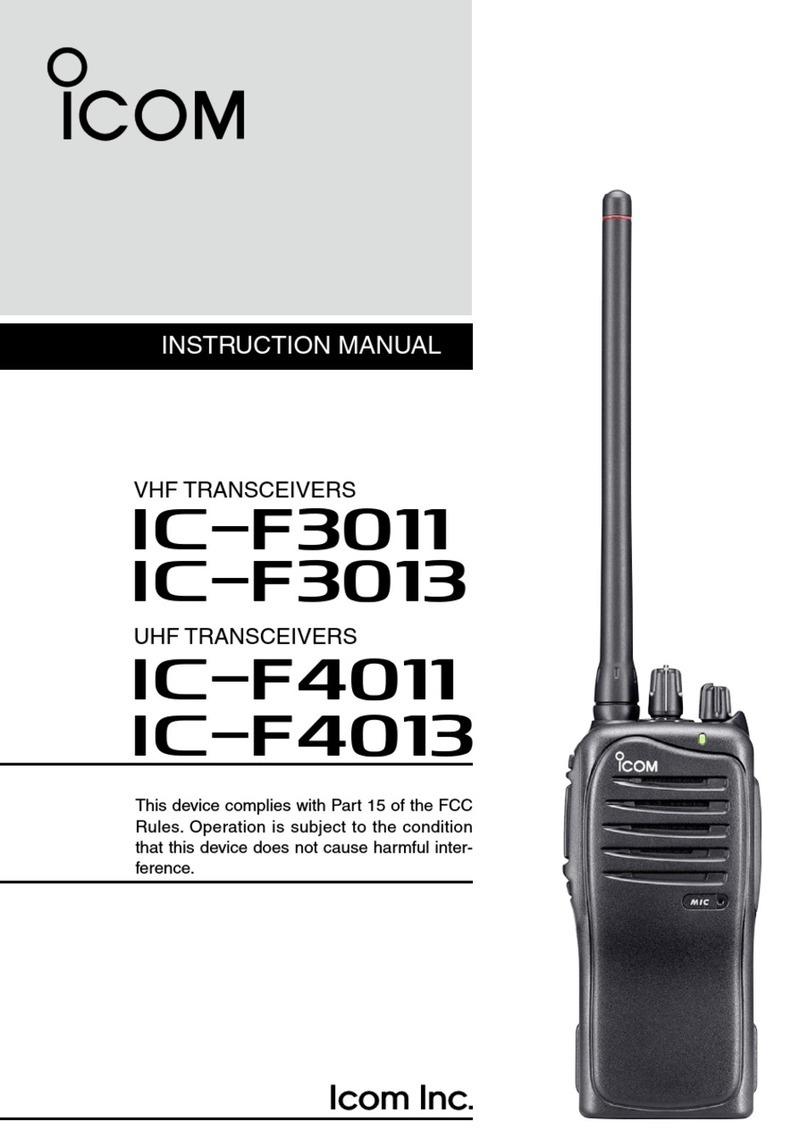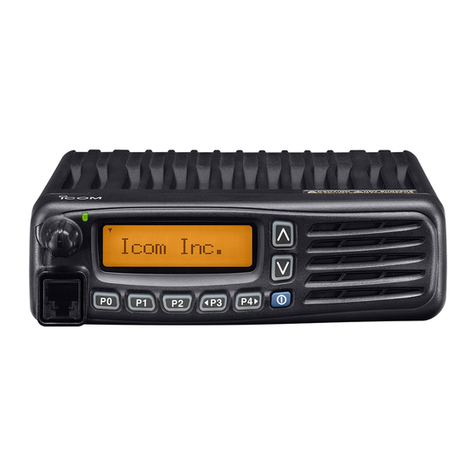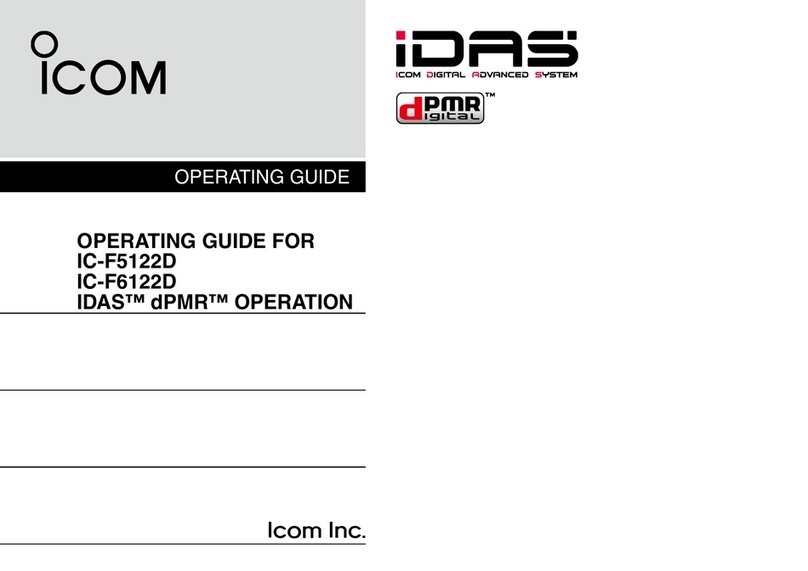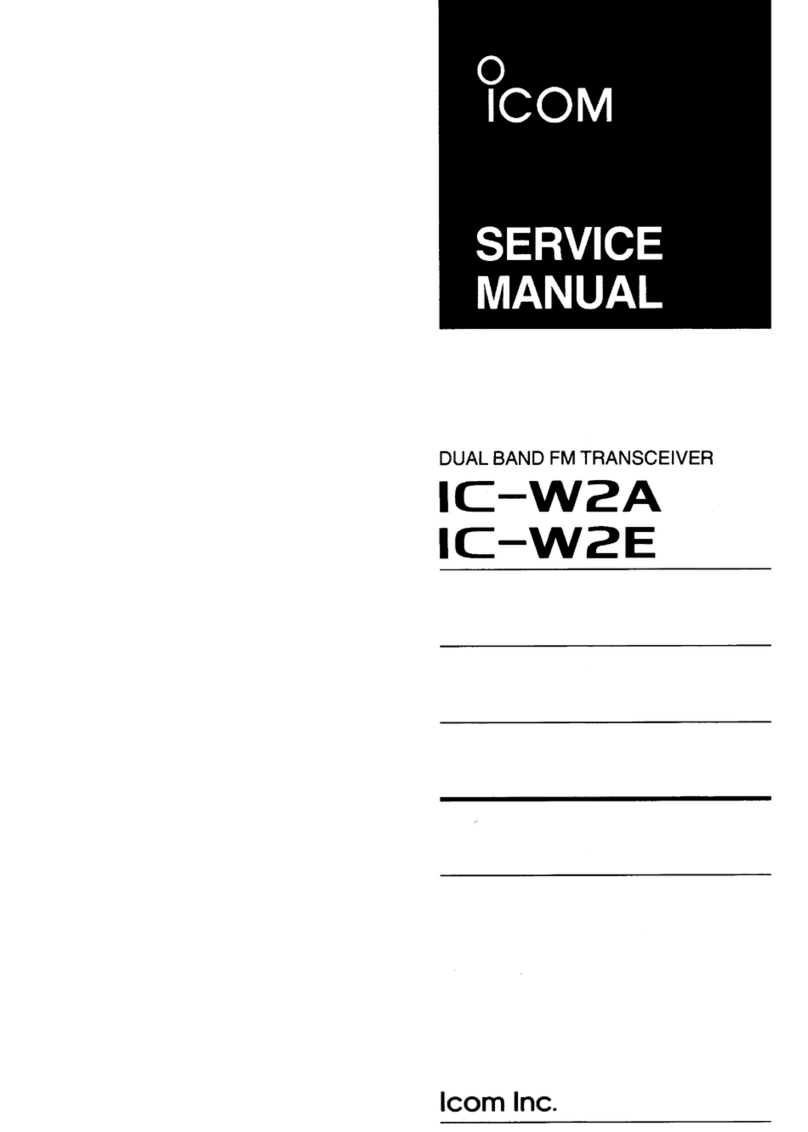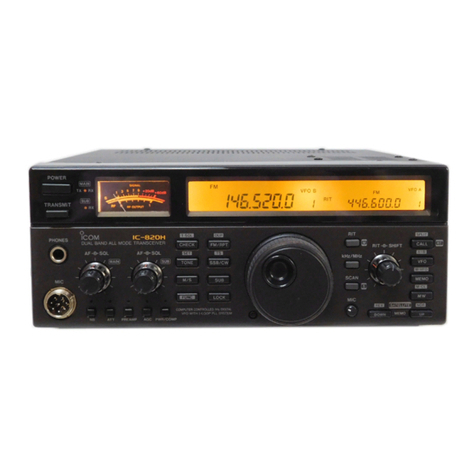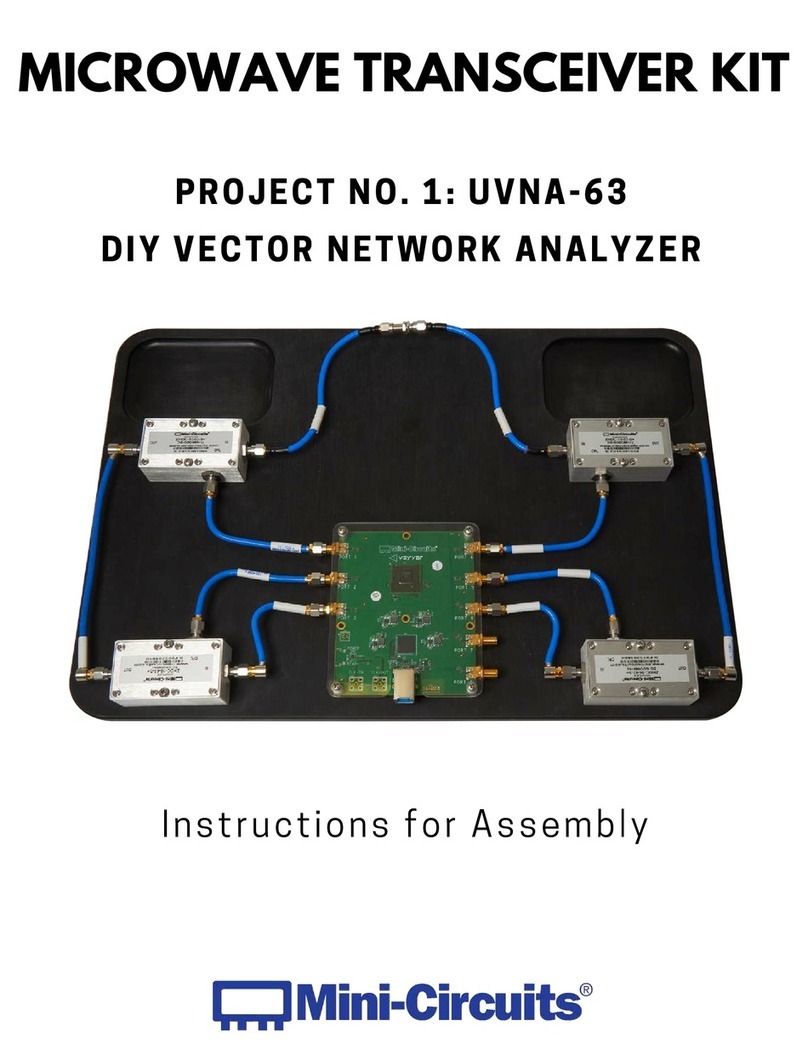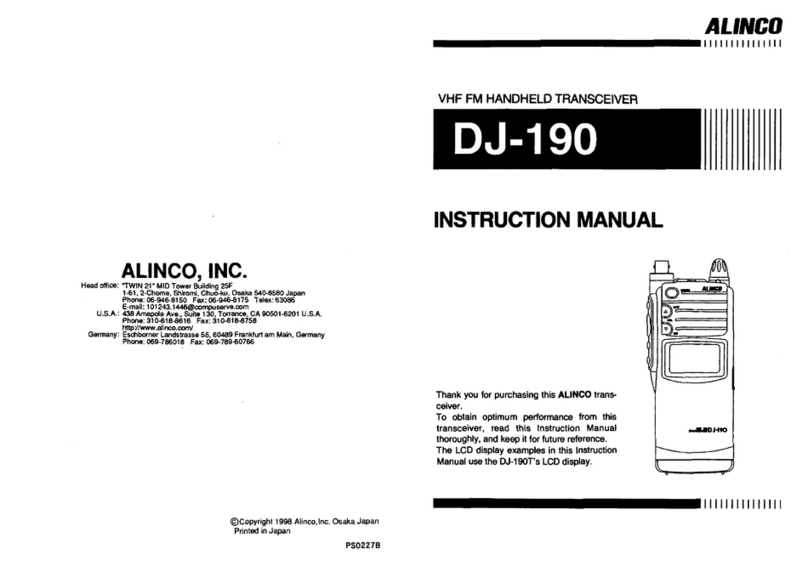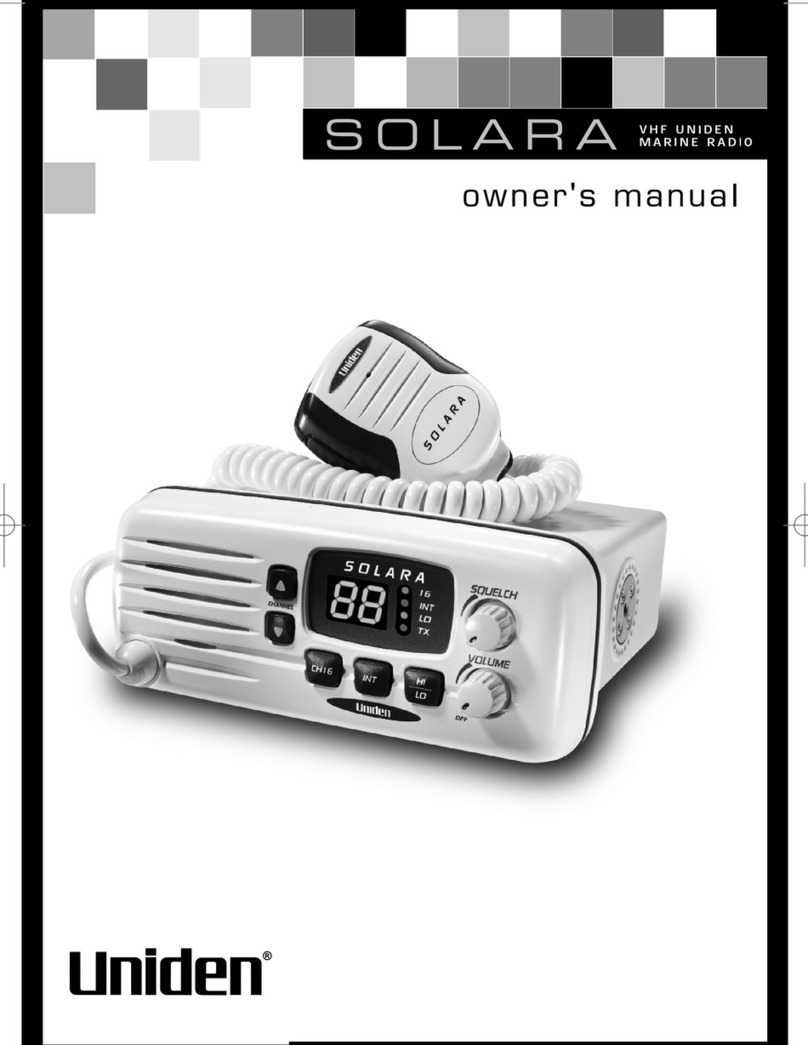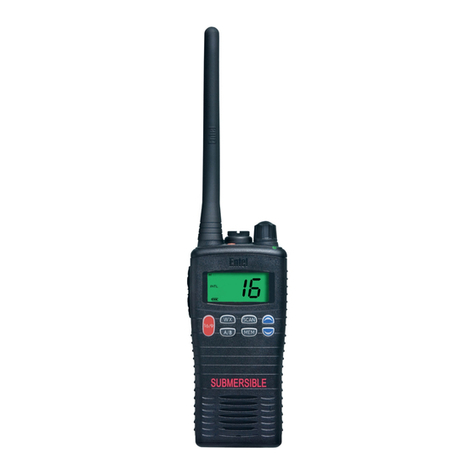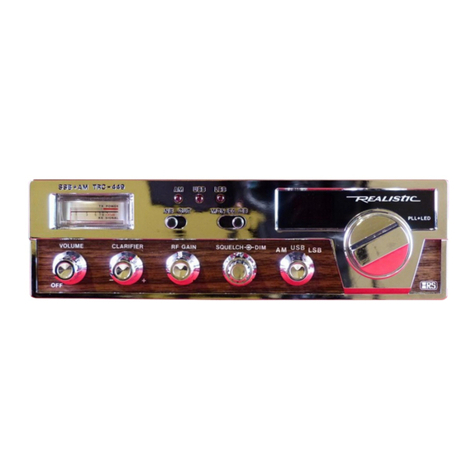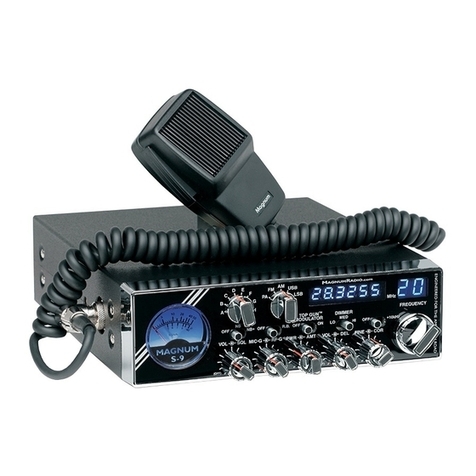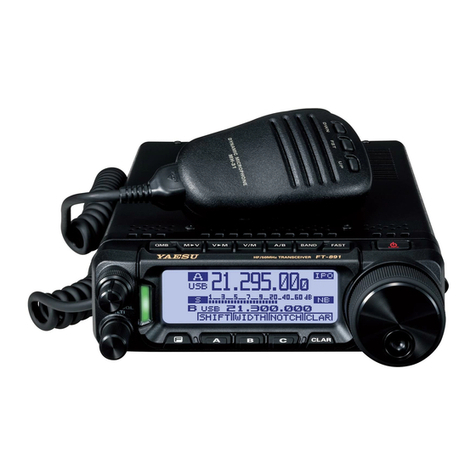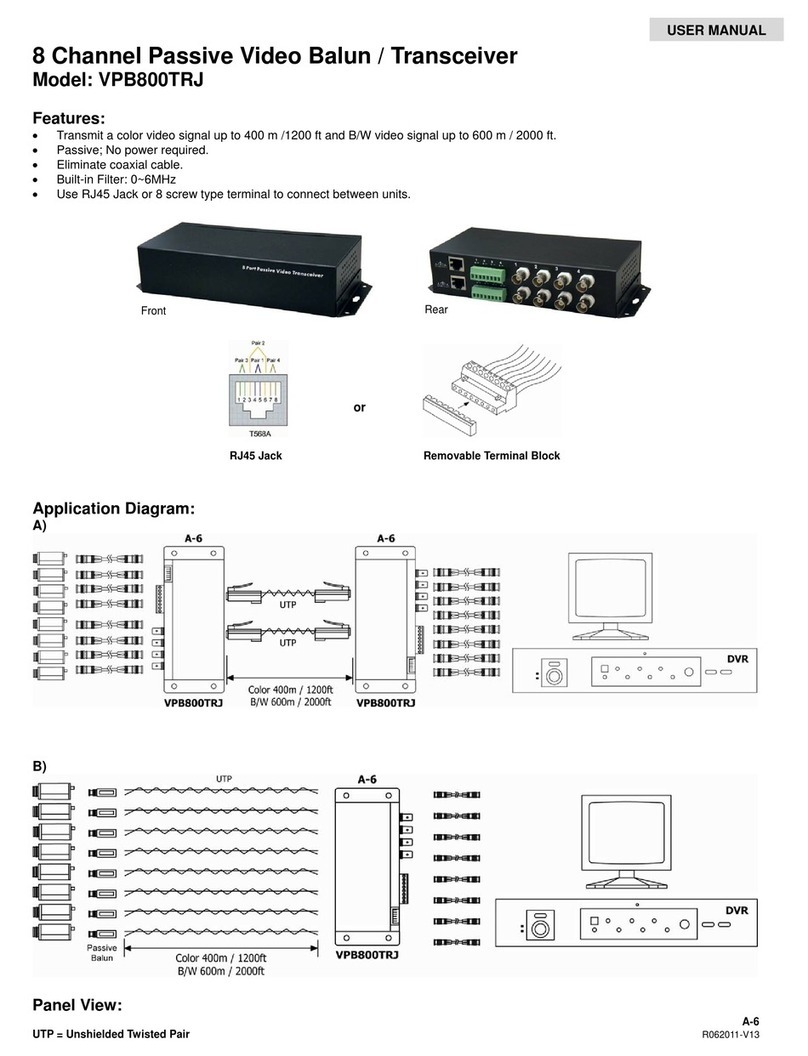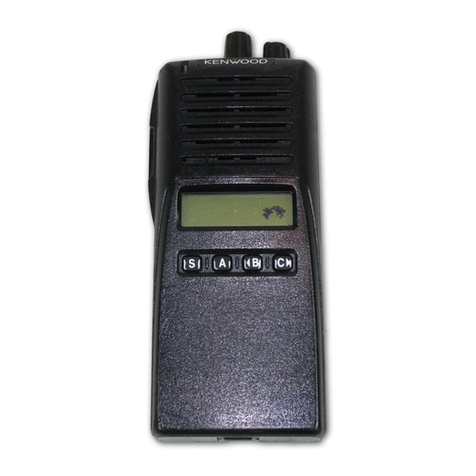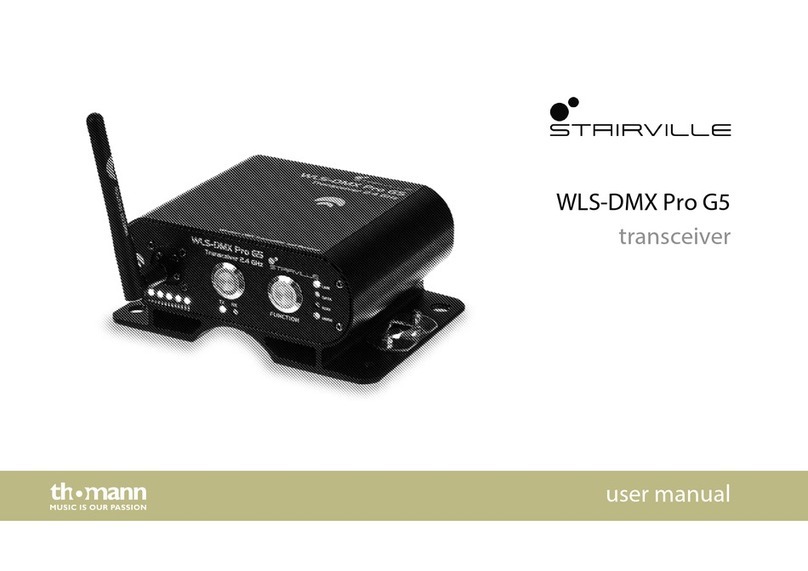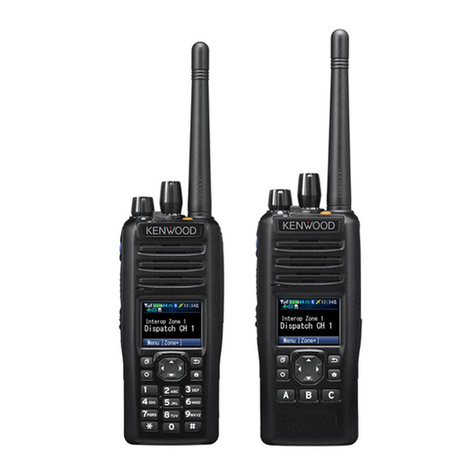Icom IC-22S User manual

Icom IC-22S
PLL Synthesized
2-Meter Transceiver
Instruction Manual
and Service Notes

Icom IC-22S PLL Synthesized 2-Meter Transceiver
Instruction Manual and Service Notes
2
SECTION I.
Specifications
GENERAL
Semiconductor Complement
Transistors 34
FET 7
IC 13
Diodes 33 to 128 depending on channels
Frequency Range (for specification) 146-148 MHz
Voltage 13.8 Volts DC (negative ground)
Current Required
TX 2.0 amps @ 10 Watts 0.9 Amps @ 1
Watt
RX 0.7 amps at maximum audio
0.4 amps squelched audio
Size 58 mm (H) x 156 mm (W) x 218 mm (D)
Weight 1.9 kilograms
Antenna Impedance 50 ohms
Number of Channels 23 channels selected from any of the
132 channels on 15 KHz spacing
Frequency Control Stabilized master oscillator PLL
programmed by diode matrix
TRANSMITTER
Power Out 10 watts or 1 watt (selectable)
Modulation Width 5 KHz
Microphone Impedance 500 ohms
Spurious Level Lower that –60 db below carrier
RECEIVER
Modulation Acceptance 16F3
Type Double Superhetrodyne
1st
IF 10.7 MHz
2nd IF 455 KHz
Receiver Sensitivity 4 db below 1 uV or lower (0.4 micro)
1 uV S+N/N 30 db or better S+N/N
Spurious Response 60 db or more attenuation
Bandpass +/-7.5 KHz: -6 db
+/-15 KHz: -60 db
Squelch Sensitivity -8 db below 1 uV
Audio Output 1.5 watts or more into 8 ohms

Icom IC-22S PLL Synthesized 2-Meter Transceiver
Instruction Manual and Service Notes
3
SECTION II.
Description
This transceiver is extremely rugged and completely solid state. State of the art devices
such as integrated circuits, field effect transistors, varactor and zener diodes are engineered
into a tight-knit, straightforward electronic design throughout both transmitter and receiver.
Reliability, low current demand, unexcelled performance, and ease of operation are the net
result.
The dual conversion receiver with its FE front end and high-Q helical cavity resonators
boasts low noise and sensitivity of 0.4 volts or less. Signal gain of 90 db or more is
accomplished from the second mixer back by virtue of a 6-stage IF amplifier. The need for
additional front end RF amplification is thus eliminated. Zener-regulated PLL controlled first
and crystal-controlled second local oscillators produce very good stability. Audio
reproduction is of an unusually high order of distortion free clarity.
The transmitter section will produce a minimum of 10 watts output. Again, a phase locked
loop is employed for initial frequency stability. Twenty-two (22) channels are provided for
operating convenience and versatility. High-Q stages provide minimum interstage spurious
response. A low pass filter is placed at the output to ensure undesirable frequency products
are not being transmitted. Final PA transistor protection circuit is incorporated in the final
circuitry. A new design heat radiator is employed to increase final reliability.
All circuitry is constructed on three printed circuit boards that are easily accessible for
servicing. The printed circuit boards are housed in a sturdy frame that is, in turn, housed in
a rigid metal case providing an extremely durable and rugged unit. Care has been taken to
filter and regulate internal DC voltages. A DC input filter is provided to eliminate alternator
or generator whine generated in the vehicle environment. Test points are brought up from
all major circuits to facilitate maintenance checks and troubleshooting should the need
arise.
Each unit comes with built-in speaker, a high quality dynamic microphone, mobile mounting
bracket, microphone clip, DC cabling and plug, external speaker plug, and operating
manual. A modern styled face plate, large S-meter, small size and low profile design
complete the unit’s styling. It is a welcome addition to a dashboard or fixed station.

Icom IC-22S PLL Synthesized 2-Meter Transceiver
Instruction Manual and Service Notes
4
SECTION III.
Installation
Unpacking
Carefully remove your transceiver from the packing carton and examine it for signs of
shipping damage. Should any shipping damage be apparent, notify the delivering carrier or
dealer immediately, stating the full extent of the damage. It is recommended you keep the
shipping cartons. In the event of storage, moving, or reshipment becomes necessary, they
come in handy. Accessory hardware, cables, etc. are packed with the transceiver. Make sure
you have not overlooked anything.
Location
Where you place the transceiver in your automobile is not critical and should be governed
by convenience and accessibility. Since the unit is so compact, many mobile possibilities
present themselves. In general, the mobile mounting bracket will provide you with some
guide as to placement. Anyplace where it can be mounted with metal screws, bolts, or pop
rivets will work. For fixed station use, a power supply should be designed to produce 3 amps
for the transceiver.
Power Requirements
The transceiver is supplied ready to operate from any regulated 13.5-volt DC, 2.5 amp
negative ground source. An automobile 12-volt, negative ground system is usually more
than adequate. Some not must be taken, however, of the condition of the vehicle’s electrical
system. Items such as low battery, worn generator/alternator, poor voltage regulator, etc.,
will impair operation of your transceiver as well as the vehicle. High noise generation or low
voltage delivery can be traced to these deficiencies. If an AC power supply other than the
matching supply is used with your transceiver, make certain it is adequately regulated for
both voltage and current. Low voltage while under load will not produce satisfactory results
from your transceiver. Receiver gain and transmitter output will be greatly impaired.
Caution against catastrophic failure of the power supply should be observed.
CAUTION: Excessive voltage (above 15 volts DC) will cause damage to your
transceiver. Be sure to check the source voltage before plugging in the
power cord.
Included with your transceiver is a DC power cable with plug attached. The red wire is
positive (+) and the black wire is negative (-). If your mobile installation permits, it is best
to connect these wires directly to the battery terminals. This arrangement eliminates
random noise and transient spikes sometimes found springing from automotive accessory
wiring. If such an arrangement is not possible, then any convenient B+ lead in the interior
of the vehicle and negative frame can be utilized. Your transceiver provides an internal DC
filter that will take out a large amount of the transient difficulties anyway. Remember that
the unit operates on a negative ground system only –it cannot be used in a positive ground
automobile.
After making your connections, simply insert the power plug into your transceiver. When
your transceiver is mated with its matching power supply, the power cable from the IC-3PA
is simply plugged into the same receptacle in the transceiver and the AC line cord into any
convenient wall receptacle.
Antenna
The most important single item that will influence the performance of any communication
system is the antenna. For that reason, a good, high quality, gain antenna of 50 ohms

Icom IC-22S PLL Synthesized 2-Meter Transceiver
Instruction Manual and Service Notes
5
impedance is recommended for fixed or mobile operation. In VHF as well as HF, every watt
o ERP effective radiated power will make a difference. Therefore, 10 watts output into a 3
db gain antenna yields 20 watts effective radiated power, assuming a low VSWR, of course.
Therefore the few more dollars invested in a gain type antenna is well worth it.
When adjusting your antenna –mobile or fixed –by all means follow the manufacturer’s
instructions. There are some pitfalls to be aware of. For example, do not attempt to adjust
the antenna for lowest VSWR when using an SWR bridge not intended for VHF use. Some
instruments will give readings with as much as a 40% error. A Drake WV-4, Bird model 43,
or Sierra model 164B with VHF cartridges
The RF coaxial connector on the rear chassis mates with a standard PL-259 connector.
Some models may have metric thread. In any event, the RF connector will mate with almost
any PL-259 connector if care is taken to seat them properly.
Microphone
A high quality dynamic microphone is supplied with your transceiver. Merely plug it into the
proper receptacle on the front panel. Should you wish to use a different microphone, make
certain it is of the high impedance type; at least 500 ohms or better. Particular care should
be exercised in wiring also, as the internal electronic switching system is dependent upon it.
See the schematic for the proper hookup. Under no circumstances use a “gain preamp” type
microphone. The audio system in your transceiver is more than adequate and additional
pre-amplification is unnecessary. To use this class of microphone is to invite distortion.
Synthesizer Programming
Your transceiver does not need crystals to set the frequency. It has 22 channels selected by
the channel selector switch. In addition, the channel selected has three options of how the
Offset is handled: receive and transmit on the programmed frequency (SPX), receive 600
kHz higher than the programmed frequency (DPX A), and transmit 600 kHz above the pro-
grammed frequency (DPX B). The programming is done on the diode matrix board by
soldering computer grade diodes into the boards in the locations indicated on the diode
matrix diagram. Please refer to the chart on pages 22~24 for the locations.

Icom IC-22S PLL Synthesized 2-Meter Transceiver
Instruction Manual and Service Notes
6
The matrix board may be removed by taking out the hold-down screw at the end of the
board and pulling gently straight up on the other end to disconnect the matrix from the
connector. The numbers 1 through 22 indicate the channel number to be programmed and
the numbers D-0 through D-7 indicate the position in which the diode is to be placed
corresponding to the insert positions on the Frequency versus Matrix Chart. Insert the diode
into the line for the desired channel with the cathode pointing UP. The cathode lead is bent
down to go through the board to connect to the other side. After the diodes have been
inserted for the channel, turn the board over carefully so as to not have the diodes fall out
and solder each of the leads with a small tip, low wattage soldering iron. Clip end diode lead
off as close to the board as possible. Replace the board on its connector and replace the
screw in the end.
An external speaker jack and plug is supplied with your unit in the event another speaker is
desirable. The external speaker impedance should be 8 ohms. The use of the external
speaker jack will disable the internal speaker. An 8 ohm headset can be utilized as well.
(See Fig. 2B)
CAUTION: DO NOT USE A SOLDERING IRON OF MORE THAN 40 WATFS ON THE MATRIX

Icom IC-22S PLL Synthesized 2-Meter Transceiver
Instruction Manual and Service Notes
7
SECTION IV.
Control Functions
High-Off-Low Switch
Opens or closes the 12 VDC source voltage to the transceiver. “In High” position, output
power is 10 watts. “In Low” position, output power is 1 watt.
DPXA —SPX —DPXB
This determines whether the transceiver transmits or receives on the program frequency, or
+600KHz above the program frequency.
Volume Control
Controls audio output level of the receiver.
Squelch Control
Controls the squelch threshold point of the receiver.
Microphone Jack
Accepts 4 prong mike plug supplied on microphone.
S/RF Meter
Reads S signal strength in receive mode and relative RF output in transmit mode. The meter
face is illuminated with a white lamp when the transceiver is switched on.
Channel Selector
Selects one of 22 channels.
C.O.S. lamp
Also shows out of lock in transmit.
Transmit Indicator
Antenna Connector
Accepts standard PL-259 coaxial connector. Note that some transceivers may come with a
metric threaded connector. Most PL-259 connectors will mate satisfactorily if care is taken
to seat them properly. If you have difficulty, try a different make of PL-259.
External Speaker Jack
This jack mates with the plug supplied for external 8-ohm speaker or headset use. The use
of this jack mutes the internal speaker.
Power Cord
Mates with DC cord plug or power cord of IC-3P AC power supply.
Identification Plate
States model, serial number.
Accessory Socket
Center Meter, etc., can be connected with a 9 Pin plug.

Icom IC-22S PLL Synthesized 2-Meter Transceiver
Instruction Manual and Service Notes
8
SECTION V.
Operation
Initial Preparations
Connect the microphone to the microphone jack.
Connect the antenna to the antenna coax connector. Make sure the coax line is of the correct
impedance (50 ohms) and is neither shorted nor open.
Make sure the function switch is in the off position, then connect the power supply cord to the
power supply jack. The red lead should be connected to the positive side of the power source and
the black lead to the negative side. In the event that these leads are improperly connected, the
transceiver will not function. No damage will be, however, incurred since protection is provided in
the P.A. for this purpose.
Turn the volume and squelch controls to the maximum counter-clockwise position.
Operation
When the function switch is set to either the high or low position the set is switched on and the
channel indicator window and meter will be illuminated.
Switch the channel selector to the desired channel.
Choose the proper DPX offset setting, or SPX for simplex operation.
Reception
Adjust the volume control to a comfortable listening level of noise, if no signal is present.
Carefully adjust the squelch control clockwise until the noise just disappears. This is the proper
squelch threshold setting and must be done when no signal is present. Your transceiver will now
remain silent until an in-coming signal is received which opens the squelch. If the squelch is
unstable due to the reception of weak or stations, adjust the squelch control further until the
proper threshold is obtained.
The S meter indicates the signal strength of the incoming stations and is calibrated in S units. and
db over S9. The light illuminating the meter acts also as lock indicator for the PCC.
Transmitting
Push the PTT (push to talk) button on the microphone and the transceiver will transmit. At the
same time the TX indicator will be illuminated red and the meter will provide an indication of
relative power output of the transmitter. The pointer will be on or near the red mark on the meter
scale when on high power and just a little over 1 on low power. Hold the microphone about three
inches from your mouth and speak in a normal voice. The microphone is of the dynamic type and
provides good pickup for all levels of voice.
To receive again, just release the PTT button. This will also switch off the light.

Icom IC-22S PLL Synthesized 2-Meter Transceiver
Instruction Manual and Service Notes
9
SECTION VI
Theory of Operation
TRANSMITTER
Microphone, pre-amplifier circuit
The pre-amplifier circuit is composed of Q30, Q29, in an NPN, PNP direct-coupled 2-stage amplifier
configuration. The low noise transistors used and application of a large amount of feedback in the
1st stage gives a high signal-to-noise ratio and high stability.
Since DC voltage is supplied through Rl39 to the microphone connector, the ICSM2 (electrolytic
condenser microphone) can be used also. C 166, R140, C65 constituting a which filter suppress
high frequency regeneration and C 163 provided between base and emitter of the 1st stage
transistor prevents oscillation due to regeneration.
Pre-amplifier output is through R132 to the microphone circuit.
IDC circuit (Instantaneous Deviation Control)
Passing of signals through narrow band filter stage can result in distortion if the signal is over-
modulated and consequent degrading of following channels. To give improved limiting
characteristics Q28, Q27, Q26, are connected in a 3-stage direct-coupled configuration that results
in less distortion and protects succeeding stages from the effects of excessive input.
Since feedback is supplied to the 3-stage DC circuit and the input impedance is low, the frequency
characteristic of the differentiation by R130 and C159 is improved. R124 through which the
feedback circuit connects to ground serves for adjusting the operating point of Q26 and insuring
symmetry of clipped waveforms. Dl 8 and D19 are temperature compensating elements for the 3-
stage DC. circuit.
The limiter output is close to square waves in form, and since it includes harmonics an active filter
is provided to eliminate anything over 3 kHz. To prevent the frequency deviation from becoming
too large as temperature increases, compensation is made by thermistor R13, after which
adjustment is made by R12 to narrow the frequency deviation range.
Frequency modulation, 10.7 MHz Oscillator
Because of the quartz crystal characteristics in the frequency modulator Q24, a non-Controlled VXO
configuration, the circuit is tolerant of temperature variations, and there is less drift. Output signals
from the IDC circuit are supplied to the anode of varicap diode D17. To improve the temperature
characteristics, temperature compensation is effected by thermistor Rl06 connected to the cathode
of D17. The signal is set to 10.7 MHz by L4 connected to the cathode of D17.
Transmission Mixer
1C3 includes a constant current circuit and differential amplifier. 1C9 provides balanced output
from the 10.7 MHz oscillator and drives the two inputs of the differential amplifier. Local oscillator
output enters via the constant current input and differential amplifier output is filtered by L36,
opposite phase components of the 10.7 MHz output and local oscillator cancel, and so signals
obtained at the secondary side of L36 are LO+/ 10.7 MHz. The required LO+ 10.7 MHz signals are
obtained from the Band Pass Filter following L36.

Icom IC-22S PLL Synthesized 2-Meter Transceiver
Instruction Manual and Service Notes
10
Interstage Amplifier
BPF output is amplified up to about 2 mW in the Q22 stage that is a MOSEFT with good linearity.
Low Level Amplifier
Interstage amplifier output is amplified to about 100 mW by stage Q19, which also functions as an
ALC circuit.
Driver stage
Low level output is amplified to approximately 1.6 W by Q18.
ALC Circuit
Spurious signals, which might occur when voltage is reduced or when the degree of excitation is
low, are prevented by a small amount of forward bias applied by bias circuit D14.
Part of this output is brought up to excitation level in the threshold type voltage-doubling rectifying
circuit constituted by D19, D29. When AI..C is not applied, the self-bias of Q5 causes Q16 to
conduct. When ALC is applied, both 015 and Q16 are close to cut-off, collector voltage of Q19 falls,
and the excitation level is lowered.
ALC is effective for both high power and low modes. For high power, the threshold level is
controlled by R73, and for low power, the threshold is set by R149.
Power Amplification
Output is amplified by Q7 to give an output of 10 watts, including low pass filter losses. Since
power handled in this stage is particularly high, use is make of an aluminum die-cast radiator
which is in direct contact with the rear chassis and serves to keep the transistor temperature low in
order to insure reliability. A padding mica trimmer which has an excellent temperature
characteristic and causes little induction loss is also employed.
Low pass filter and SWR detector
Power amplifier output includes harmonic components and in passing through 2 Chebyshev section
and one standard section in order to get to the ANT terminal, harmonic components are attenuated
by about 70 dB. Cut-off frequency of this low-pass filter is set to about 180MHz, and so there is
very little loss in the 146-148 MHz band.
SWR
D10, D11 constitute an SWR detector. The closer it is to the ANT terminal the better the detector
functions, but because of diode rectification, harmonics are produced. An excellent compromise is
therefore made by inserting the detector between the low-pass filters. Standing waves that pass
through the SWR detector are rectified by D11 and supplied to the RF meter. Indication of the RF
meter for proper high power output is set to 4/5 of full-scale by R156.
APC circuit
Reflected waves are rectified by D10 and then amplified by Q20, 021 up to the level set by 89. By
raising Q22 source voltage, excitation level is lowered, and damage to the power amplifier
transistor due to mismatch is prevented.

Icom IC-22S PLL Synthesized 2-Meter Transceiver
Instruction Manual and Service Notes
11
RECEIVER
R.F. Amplifier
Antenna input or self contained antenna signals pass through switching diode D-40 located in the
PA section to the RF amplifier Q2 where it is amplified and passed to the R.F. filter section. Out-of-
band signals are attenuated by the band pass filters.
Mixer Filter
The amplifier signal is injected into Gate-iof the mixer Q-3. The LO frequency is also applied to Q3
where a resultant 10.7 MHz IF signal is derived. This signal is passed through a crystal BP filter
that greatly attenuates other in-band signals. The 10.7 MHz signal is again mixed with a second
local oscillator, Q8 operating at 10.245 MHz at mixer 2, Q4. The resulting mixer output is 455 kHz.
I. F. Amplifiers
Two ceramic filters provide the low frequency selectivity and the adjacent channel rejection needed
in today’s crowded repeater world. I.F. amplifiers Q5 and Q7 drive IC1 limiter. The signal is
detected by the ceramic discriminator.
Audio
Lower frequency audio components (300 Hz to 3 kHz) are amplified by Q1O and passed by Q11
active filter. These (desired) audio signals are adjusted to level by the volume control and amplified
to I watt power by IC-2.
Squelch
At point J-5, higher frequency discriminator noise is taken at a selected level by the R1 squelch
Control back via J4 and amplified by Q14 and Q13 rectified by D7 and applied to Q12’s base. Under
no signal conditions, when noise is high, this rectified voltage is high, and Q12 turns off Q11. The
reverse is true when a signal is of sufficient strength to reduce noise and the squelch opens
permitting the audio signal path to operate normally.
During transmit, positive voltage is fed to the Q9 base, silencing the audio system. After switching
back to receive, a delay in Q9 base voltage change provided by C-56 allows a silent transition.
PHASE LOCKED LOOP
Voltage controlled oscillator
Use of a clap oscillator in the form of a junction FET in Q8 gives an improved signal-to-noise, and
by use of other elements having excellent temperature characteristics, frequency stability of the
order of +/50 ppm/C is achieved.
Varicap diode D3 serves to broaden the range of frequency permitted and by contributing to the
linearity improves stability of the circuit as a whole.
Buffer amplifier
In Q5, a MOSEFT using very little feedback minimizes the effects of load variation, and the
necessary LO output of 400 mV of the main unit is obtained.

Icom IC-22S PLL Synthesized 2-Meter Transceiver
Instruction Manual and Service Notes
12
Local oscillator
The overtone oscillator in Q7 is provided to reduce spurious signals resulting from multiplication of
the fundamental oscillator. L6 is provided in series with the crystal to facilitate frequency
adjustment. L5, which is connected to the collector, is tuned to a frequency that is three (3) times
the overtone oscillator output, giving a frequency of 133.69 MHz.
Frequency converter
Balanced mixer 1C4 is a voltage regulator and a differential amplifier. A portion of the buffer
amplifier output is fed to the voltage regulator portion of 1C4 and input to the differential amplifier
is the local oscillator output. This is fed through U to balance the transformation of pulses. Using
this frequency conversion technique employing the MHz signal insures the elimination of spurious
signals in the PLL output.
Low pass filter
The Heterodyning process in various frequencies being present at the output of ICC4, but the LPF
passes only the frequencies of 6 MHz or lower.
Limiting amplifier
Since the level of the LPF output is small, a broad band amplifier ICS consisting of 3 differential
amplifier stages is provided to amplify these signals. The interface with the divide by two circuit is
transistor Q6.
Divide by two
Since maximum operating frequency of ICI is low, ½ of 1C6, whose operating frequency is high,
divides the Q6 output frequency by 2, to give signals of approximately 3 MHz or less which are
supplied to the programmable divider.
Programmable divider
IC! divides the 1C6 output using a frequency division ratio determined by the program set by the
diode matrix.
This IC operates in binary and the maximum dividing ratio is 255. Because of this circuit’s action,
lock is not released when VCO free-running oscillations are at the upper frequency limit. At the low
frequency limit, lock-up is terminated when the frequency of the VCO is lower than a value equal to
the local oscillator frequency plus N times the reference frequencies. When power is connected, the
transient voltage of the differentiating circuit defined by C24, R2 is passed through D2, and
potential at the varicap diode temporarily goes to a high value. As this voltage falls, and the value
set by the programmable divider N is entered, D2 is reverse-biased, and in normal conditions is off.
By putting D4 in parallel to R12 the charge on C4 is discharged quickly when power is switched off,
and when power is connected again the lock circuit is reset.
Diode Matrix
This is a binary code, read only memory, defining a frequency as a binary number. This matrix
determines the frequency dividing ratio (N) to be employed by the programmable divider in order
to obtain the frequency required in response to activation of each of the 22 switch positions.
See diode matrix charts

Icom IC-22S PLL Synthesized 2-Meter Transceiver
Instruction Manual and Service Notes
13
Reference oscillator divider
IC3 is an IC used to produce the reference frequency for the synthesizer, and includes a quartz
crystal oscillator and a 12-stage high speed divider. The oscillator produces 7.68 MHz oscillations
which the high-speed divider section divides by 1024 to give the 7.5 kHz reference pulses.
Phase detection loop filter
IC2 is a phase detector for the frequency synthesizer and is made up of a digital phase comparator
and an amplifier for the active low-pass filter. Reference pulses from 1C3 are supplied to IC2 Pin 7
and divided pulses from ICl to 1C2 Pin 8, and the digital phase comparator produces output which
is proportional to the difference in phase of these inputs, and is taken out at 1C2 Pin 3. Damping
factor of this output is set at 0.6. Lock-up time is set to 50 msec, 25% overshoot by a lag-lead
filter consisting of R9, R10, R8, C10 and the filter amplifier in 1C2.
If the divider output frequency becomes higher than the reference frequency, output voltage of the
lag-lead filter becomes low and the VCO frequency is lowered. When the divider output frequency
becomes low, circuit action is the reverse, and the VCO synchronizes the output with the reference
frequency.
Lock indication circuit, transmission termination circuit
At 1C2 Pin 4 there is a pulse output which is equal to VCC of Pin 5 when reference pulses and
divider output have the same frequency. When these inputs to 1C2 are not phase locked they have
a width proportional to the phase difference of the inputs. Pin 4 output pulses are integrated by R7,
C8, and when the integrated value obtained exceeds the junction potential of Q4, Q4 conducts and
Qi of the next stage also is turned on.
Transmission is terminated when current flowing through Dl connected to the Qi collector causes
base voltage of main unit Q32 to be lowered and the lock is released. As the transmit 9V supply
comes down, the signal lamp lights during transmission to indicate that lock-up is no longer in
effect. When Q2 base bias disappears, the meter lamp goes out both for transmit and receive and,
together with the signal lamp, indicates that lock is not present.
Ripple filter
The ripple filter, Q3, acts to further smooth the 9V supply and so protect the VCO phase
comparator and loop filter against voltage variations and improve stability.
Lock start circuit
When PLL lock is applied, the upper frequency limit is determined mainly by the operating
frequency of the divider ½ 1C6, and the VCO filter L7 is set so that oscillation is at this upper limit
when loop filter output is at maximum.
LO switching circuit
1st LO output from PLL is supplied to J1 and J2. While receiving, forward bias passes through RiO,
L43, R155, and flows through Dl5. D15 is switched on so the 1st LO is directed to L43.
Similarly, during transmit, forward current passes through R96, R155, flows through in D16, which
is switched on and 1st LO is supplied to 1C3.

Icom IC-22S PLL Synthesized 2-Meter Transceiver
Instruction Manual and Service Notes
14
Power supply
Reverse connection protection circuit
If power with the wrong polarity is applied, D28 is forward biased and there is, therefore, a large
current flow which blows the fuse provided on the external lead, preventing damage to circuit
elements.
Power supply circuit, stand-by circuit
The constant 9 V supply appears as regulated voltage at the anode of D20 due to the action of the
clamp circuit of R142, D20, and zener diode D21. This voltage is sent by the emitter-follower circuit
Q3i and supplied to the PLL, IDC circuit, reception AF circuit, and the low pass filter group.
Similarly, 9 V for reception is taken from the clamp circuit of R147, D27, and D21 by Q34 in an
emitter-follower configuration. This voltage is supplied to the RF, IF, 2nd LO and noise amplification
circuits.
The 9 V for transmit is similarly taken from emitter-follower circuit Q32 from the clamp circuit
constituted by Ri43, D22, D21, and is supplied to the IDC, 10.7 MHz oscillator, transmission mixer,
inter-stage amplifier, and bias circuits.
The 13.8 V supply is supplied to the ALC DC amplifier, exciting amplifier, power amplifier, and IC2.
In the stand-by mode, when the PTT switch is switched off, D24 and D26 are both non-conductive
and +9 V for reception is obtained. Since D25 also is switched off, Q33 conducts due to bias
established by R145. The base of Q32 is connected to ground through D3, and transmit voltage
ceases.
When the PU switch is switched on, the base of Q34 is connected to ground through D26 and the 9
V receive supply dies. D24 connected to the emitter of Q34 is used for effecting rapid discharge of
the electrolytic condenser connected to the 9 V receive supply line. Q33 becomes non-conductive
since its base is connected to ground through D2 5, and 9 V for transmit is obtained.

Icom IC-22S PLL Synthesized 2-Meter Transceiver
Instruction Manual and Service Notes
15
SECTION VII
Charts
Diode Matrix Chart
Freq. "N" +Offset -Offset D7 D6 D5 D4 D3 D2 D1 D0
144.390 0144.990 143.790 00000000
144.405 1145.005 143.805 00000001
144.420 2145.020 143.820 00000010
144.435 3145.035 143.835 00000011
144.450 4145.050 143.850 00000100
144.465 5145.065 143.865 00000101
144.480 6145.080 143.880 00000110
144.495 7145.095 143.895 00000111
144.510 8145.110 143.910 00001000
144.525 9145.125 143.925 00001001
144.540 10 145.140 143.940 00001010
144.555 11 145.155 143.955 00001011
144.570 12 145.170 143.970 00001100
144.585 13 145.185 143.985 00001101
144.600 14 145.200 144.000 00001110
144.615 15 145.215 144.015 00001111
144.630 16 145.230 144.030 00010000
144.645 17 145.245 144.045 00010001
144.660 18 145.260 144.060 00010010
144.675 19 145.275 144.075 00010011
144.690 20 145.290 144.090 00010100
144.705 21 145.305 144.105 00010101
144.720 22 145.320 144.120 00010110
144.735 23 145.335 144.135 00010111
144.750 24 145.350 144.150 00011000
144.765 25 145.365 144.165 00011001
144.780 26 145.380 144.180 00011010
144.795 27 145.395 144.195 00011011
144.810 28 145.410 144.210 00011100
144.825 29 145.425 144.225 00011101
144.840 30 145.440 144.240 00011110
144.855 31 145.455 144.255 00011111
144.870 32 145.470 144.270 00100000
144.885 33 145.485 144.285 00100001
144.900 34 145.500 144.300 00100010
144.915 35 145.515 144.315 00100011
144.930 36 145.530 144.330 00100100
144.945 37 145.545 144.345 00100101
144.960 38 145.560 144.360 00100110
144.975 39 145.575 144.375 00100111
144.990 40 145.590 144.390 00101000
145.005 41 145.605 144.405 00101001

Icom IC-22S PLL Synthesized 2-Meter Transceiver
Instruction Manual and Service Notes
16
Freq. "N" +Offset -Offset D7 D6 D5 D4 D3 D2 D1 D0
145.020 42 145.620 144.420 00101010
145.035 43 145.635 144.435 00101011
145.050 44 145.650 144.450 00101100
145.065 45 145.665 144.465 00101101
145.080 46 145.680 144.480 00101110
145.095 47 145.695 144.495 00101111
145.110 48 145.710 144.510 00110000
145.125 49 145.725 144.525 00110001
145.140 50 145.740 144.540 00110010
145.155 51 145.755 144.555 00110011
145.170 52 145.770 144.570 00110100
145.185 53 145.785 144.585 00110101
145.200 54 145.800 144.600 00110110
145.215 55 145.815 144.615 00110111
145.230 56 145.830 144.630 00111000
145.245 57 145.845 144.645 00111001
145.260 58 145.860 144.660 00111010
145.275 59 145.875 144.675 00111011
145.290 60 145.890 144.690 00111100
145.305 61 145.905 144.705 00111101
145.320 62 145.920 144.720 00111110
145.335 63 145.935 144.735 00111111
145.335 63 145.935 144.735 00111111
145.350 64 145.950 144.750 01000000
145.365 65 145.965 144.765 01000001
145.380 66 145.980 144.780 01000010
145.395 67 145.995 144.795 01000011
145.410 68 146.010 144.810 01000100
145.425 69 146.025 144.825 01000101
145.440 70 146.040 144.840 01000110
145.455 71 146.055 144.855 01000111
145.470 72 146.070 144.870 01001000
145.485 73 146.085 144.885 01001001
145.500 74 146.100 144.900 01001010
145.515 75 146.115 144.915 01001011
145.530 76 146.130 144.930 01001100
145.545 77 146.145 144.945 01001101
145.560 78 146.160 144.960 01001110
145.575 79 146.175 144.975 01001111
145.590 80 146.190 144.990 01010000
145.605 81 146.205 145.005 01010001
145.620 82 146.220 145.020 01010010
145.635 83 146.235 145.035 01010011
145.650 84 146.250 145.050 01010100
145.665 85 146.265 145.065 01010101
145.680 86 146.280 145.080 01010110
145.695 87 146.295 145.095 01010111

Icom IC-22S PLL Synthesized 2-Meter Transceiver
Instruction Manual and Service Notes
17
Freq. "N" +Offset -Offset D7 D6 D5 D4 D3 D2 D1 D0
145.710 88 146.310 145.110 01011000
145.725 89 146.325 145.125 01011001
145.740 90 146.340 145.140 01011010
145.755 91 146.355 145.155 01011011
145.770 92 146.370 145.170 01011100
145.785 93 146.385 145.185 01011101
145.800 94 146.400 145.200 01011110
145.815 95 146.415 145.215 01011111
145.815 95 146.415 145.215 01011111
145.830 96 146.430 145.230 01100000
145.845 97 146.445 145.245 01100001
145.860 98 146.460 145.260 01100010
145.875 99 146.475 145.275 01100011
145.890 100 146.490 145.290 01100100
145.905 101 146.505 145.305 01100101
145.920 102 146.520 145.320 01100110
145.935 103 146.535 145.335 01100111
145.950 104 146.550 145.350 01101000
145.965 105 146.565 145.365 01101001
145.980 106 146.580 145.380 01101010
145.995 107 146.595 145.395 01101011
146.010 108 146.610 145.410 01101100
146.025 109 146.625 145.425 01101101
146.040 110 146.640 145.440 01101110
146.055 111 146.655 145.455 01101111
146.070 112 146.670 145.470 01110000
146.085 113 146.685 145.485 01110001
146.100 114 146.700 145.500 01110010
146.115 115 146.715 145.515 01110011
146.130 116 146.730 145.530 01110100
146.145 117 146.745 145.545 01110101
146.160 118 146.760 145.560 01110110
146.175 119 146.775 145.575 01110111
146.190 120 146.790 145.590 01111000
146.205 121 146.805 145.605 01111001
146.220 122 146.820 145.620 01111010
146.235 123 146.835 145.635 01111011
146.250 124 146.850 145.650 01111100
146.265 125 146.865 145.665 01111101
146.280 126 146.880 145.680 01111110
146.295 127 146.895 145.695 01111111
146.310 128 146.910 145.710 10000000
146.325 129 146.925 145.725 10000001
146.340 130 146.940 145.740 10000010
146.355 131 146.955 145.755 10000011
146.370 132 146.970 145.770 10000100
146.385 133 146.985 145.785 10000101

Icom IC-22S PLL Synthesized 2-Meter Transceiver
Instruction Manual and Service Notes
18
Freq. "N" +Offset -Offset D7 D6 D5 D4 D3 D2 D1 D0
146.400 134 147.000 145.800 10000110
146.415 135 147.015 145.815 10000111
146.430 136 147.030 145.830 10001000
146.445 137 147.045 145.845 10001001
146.460 138 147.060 145.860 10001010
146.475 139 147.075 145.875 10001011
146.490 140 147.090 145.890 10001100
146.505 141 147.105 145.905 10001101
146.520 142 147.120 145.920 10001110
146.535 143 147.135 145.935 10001111
146.550 144 147.150 145.950 10010000
146.565 145 147.165 145.965 10010001
146.580 146 147.180 145.980 10010010
146.595 147 147.195 145.995 10010011
146.610 148 147.210 146.010 10010100
146.625 149 147.225 146.025 10010101
146.640 150 147.240 146.040 10010110
146.655 151 147.255 146.055 10010111
146.670 152 147.270 146.070 10011000
146.685 153 147.285 146.085 10011001
146.700 154 147.300 146.100 10011010
146.715 155 147.315 146.115 10011011
146.730 156 147.330 146.130 10011100
146.745 157 147.345 146.145 10011101
146.760 158 147.360 146.160 10011110
146.775 159 147.375 146.175 10011111
146.775 159 147.375 146.175 10011111
146.790 160 147.390 146.190 10100000
146.805 161 147.405 146.205 10100001
146.820 162 147.420 146.220 10100010
146.835 163 147.435 146.235 10100011
146.850 164 147.450 146.250 10100100
146.865 165 147.465 146.265 10100101
146.880 166 147.480 146.280 10100110
146.895 167 147.495 146.295 10100111
146.910 168 147.510 146.310 10101000
146.925 169 147.525 146.325 10101001
146.940 170 147.540 146.340 10101010
146.955 171 147.555 146.355 10101011
146.970 172 147.570 146.370 10101100
146.985 173 147.585 146.385 10101101
147.000 174 147.600 146.400 10101110
147.015 175 147.615 146.415 10101111
147.030 176 147.630 146.430 10110000
147.045 177 147.645 146.445 10110001
147.060 178 147.660 146.460 10110010
147.075 179 147.675 146.475 10110011

Icom IC-22S PLL Synthesized 2-Meter Transceiver
Instruction Manual and Service Notes
19
Freq. "N" +Offset -Offset D7 D6 D5 D4 D3 D2 D1 D0
147.090 180 147.690 146.490 10110100
147.105 181 147.705 146.505 10110101
147.120 182 147.720 146.520 10110110
147.135 183 147.735 146.535 10110111
147.150 184 147.750 146.550 10111000
147.165 185 147.765 146.565 10111001
147.180 186 147.780 146.580 10111010
147.195 187 147.795 146.595 10111011
147.210 188 147.810 146.610 10111100
147.225 189 147.825 146.625 10111101
147.240 190 147.840 146.640 10111110
147.255 191 147.855 146.655 10111111
147.255 191 147.855 146.655 10111111
147.270 192 147.870 146.670 11000000
147.285 193 147.885 146.685 11000001
147.300 194 147.900 146.700 11000010
147.315 195 147.915 146.715 11000011
147.330 196 147.930 146.730 11000100
147.345 197 147.945 146.745 11000101
147.360 198 147.960 146.760 11000110
147.375 199 147.975 146.775 11000111
147.390 200 147.990 146.790 11001000
147.405 201 148.005 146.805 11001001
147.420 202 148.020 146.820 11001010
147.435 203 148.035 146.835 11001011
147.450 204 148.050 146.850 11001100
147.465 205 148.065 146.865 11001101
147.480 206 148.080 146.880 11001110
147.495 207 148.095 146.895 11001111
147.510 208 148.110 146.910 11010000
147.525 209 148.125 146.925 11010001
147.540 210 148.140 146.940 11010010
147.555 211 148.155 146.955 11010011
147.570 212 148.170 146.970 11010100
147.585 213 148.185 146.985 11010101
147.600 214 148.200 147.000 11010110
147.615 215 148.215 147.015 11010111
147.630 216 148.230 147.030 11011000
147.645 217 148.245 147.045 11011001
147.660 218 148.260 147.060 11011010
147.675 219 148.275 147.075 11011011
147.690 220 148.290 147.090 11011100
147.705 221 148.305 147.105 11011101
147.720 222 148.320 147.120 11011110
147.735 223 148.335 147.135 11011111
147.735 223 148.335 147.135 11011111
147.750 224 148.350 147.150 11100000

Icom IC-22S PLL Synthesized 2-Meter Transceiver
Instruction Manual and Service Notes
20
Freq. "N" +Offset -Offset D7 D6 D5 D4 D3 D2 D1 D0
147.765 225 148.365 147.165 11100001
147.780 226 148.380 147.180 11100010
147.795 227 148.395 147.195 11100011
147.810 228 148.410 147.210 11100100
147.825 229 148.425 147.225 11100101
147.840 230 148.440 147.240 11100110
147.855 231 148.455 147.255 11100111
147.870 232 148.470 147.270 11101000
147.885 233 148.485 147.285 11101001
147.900 234 148.500 147.300 11101010
147.915 235 148.515 147.315 11101011
147.930 236 148.530 147.330 11101100
147.945 237 148.545 147.345 11101101
147.960 238 148.560 147.360 11101110
147.975 239 148.575 147.375 11101111
147.990 240 148.590 147.390 11110000
148.005 241 148.605 147.405 11110001
148.020242 148.620 147.420 11110010
148.035 243 148.635 147.435 11110011
148.050 244 148.650 147.450 11110100
148.065 245 148.665 147.465 11110101
148.080 246 148.680 147.480 11110110
148.095 247 148.695 147.495 11110111
148.110 248 148.710 147.510 11111000
148.125 249 148.725 147.525 11111001
148.140 250 148.740 147.540 11111010
148.155 251 148.755 147.555 11111011
148.170 252 148.770 147.570 11111100
148.185 253 148.785 147.585 11111101
148.200 254 148.800 147.600 11111110
148.215 255 148.815 147.615 11111111
Table of contents
Other Icom Transceiver manuals
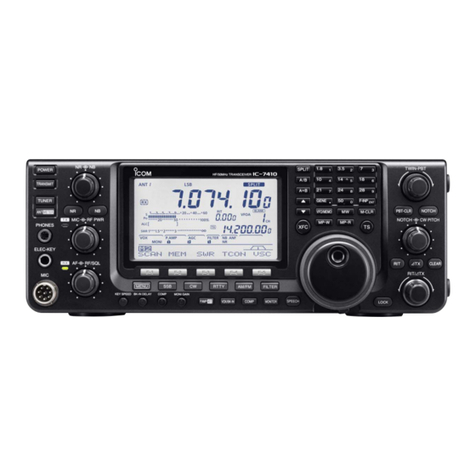
Icom
Icom IC-i7410 User manual
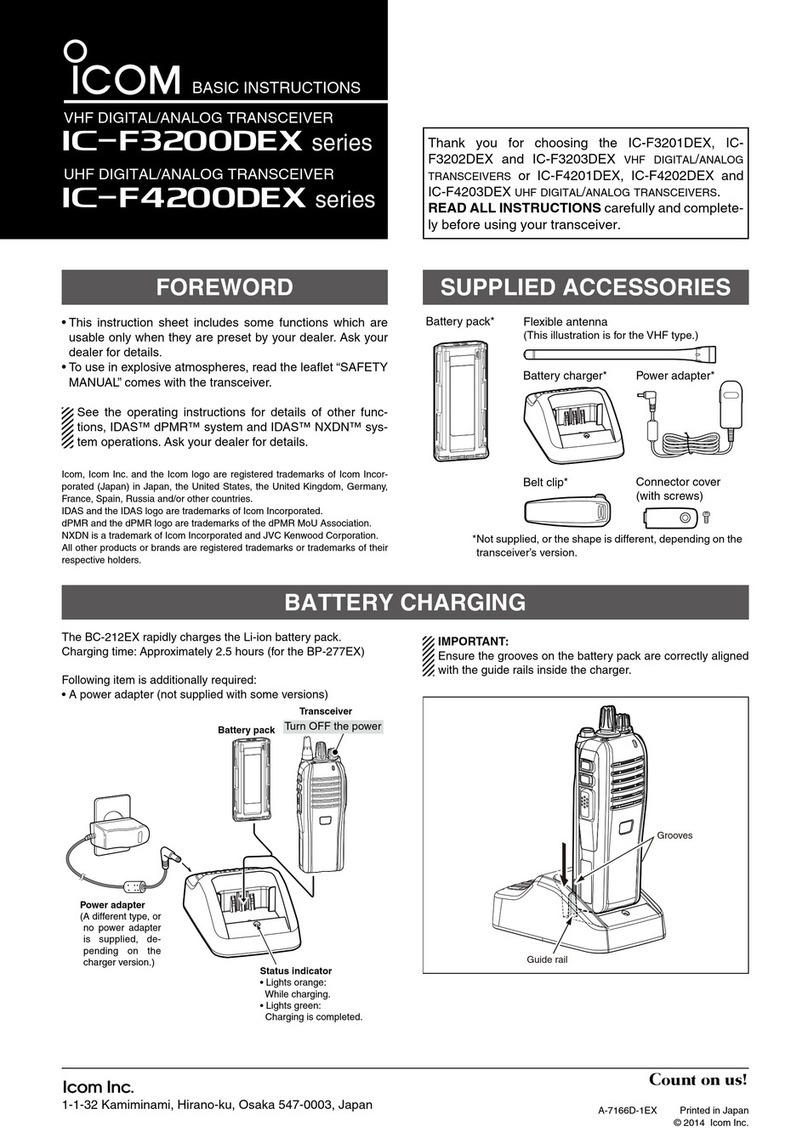
Icom
Icom IC-F3201DEX Installation guide
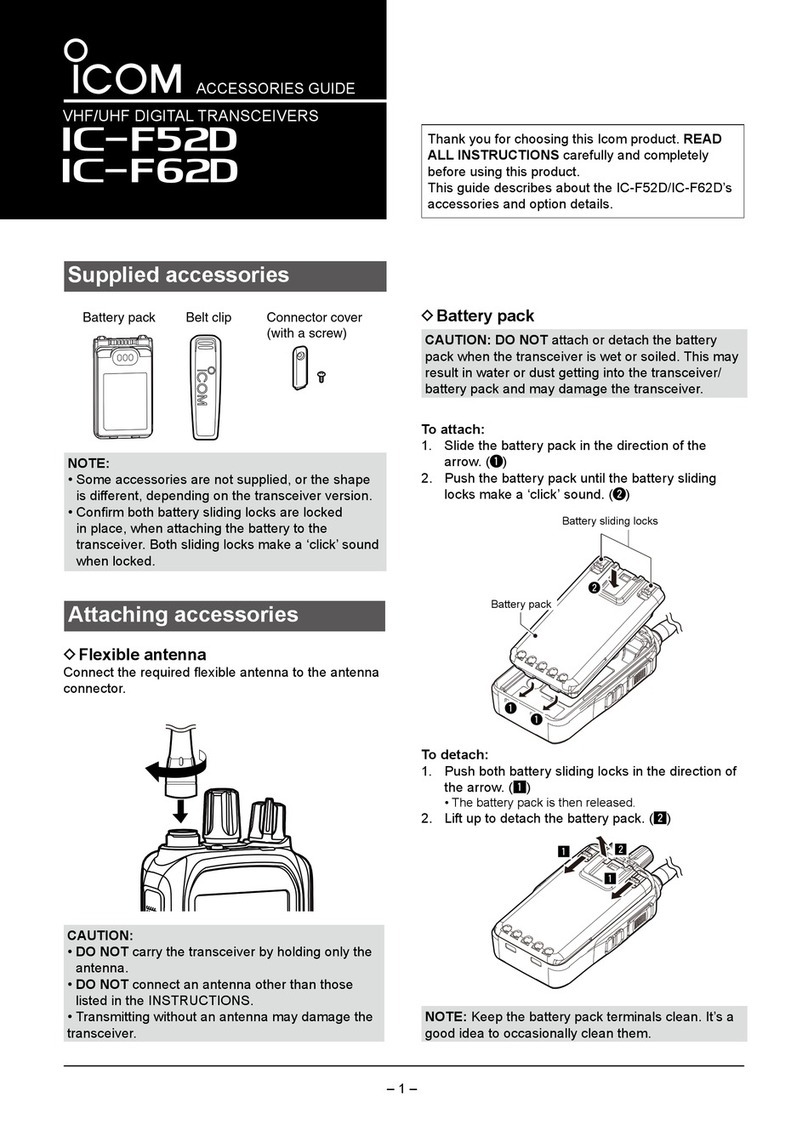
Icom
Icom IC-F52D User manual
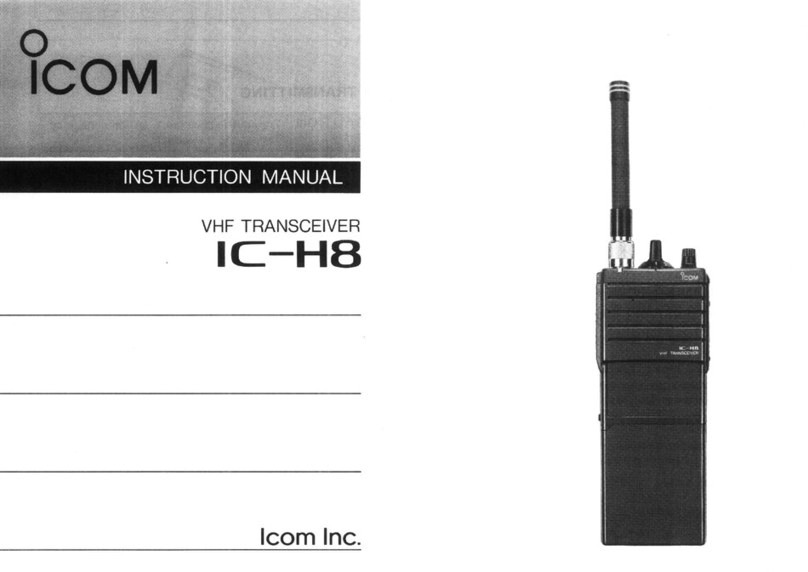
Icom
Icom IC-H8 User manual
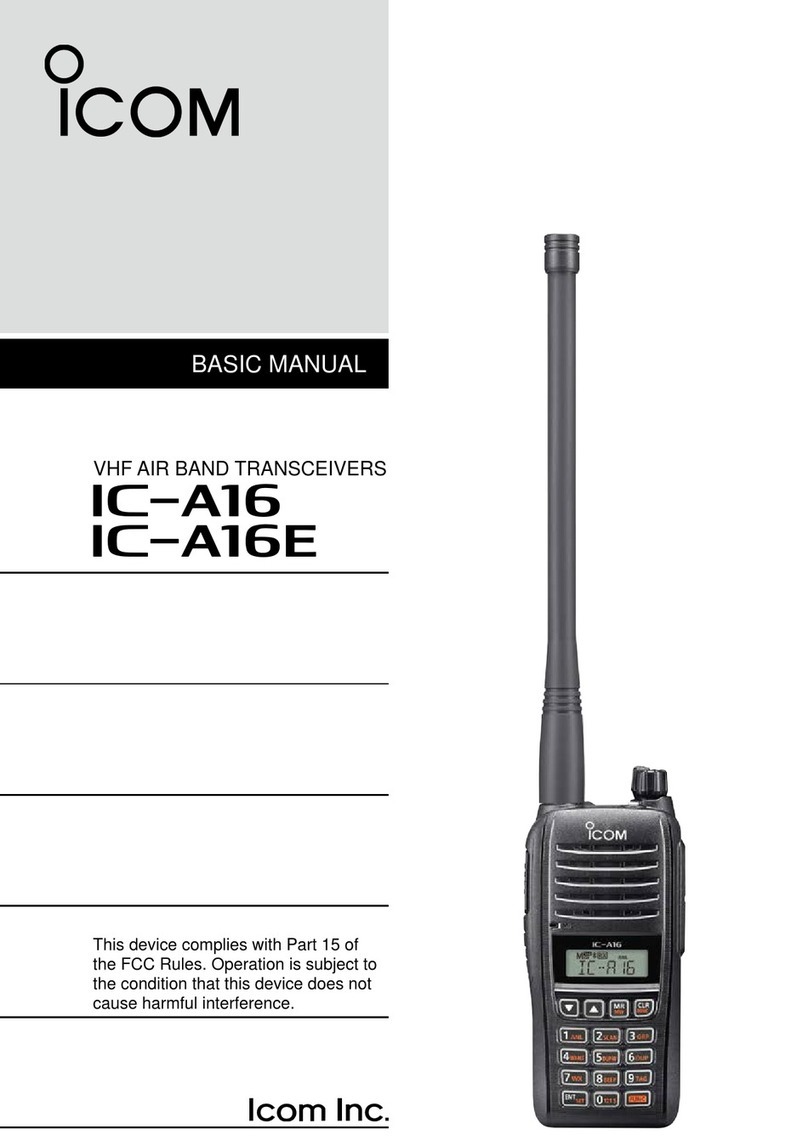
Icom
Icom IC-A16E Installation guide
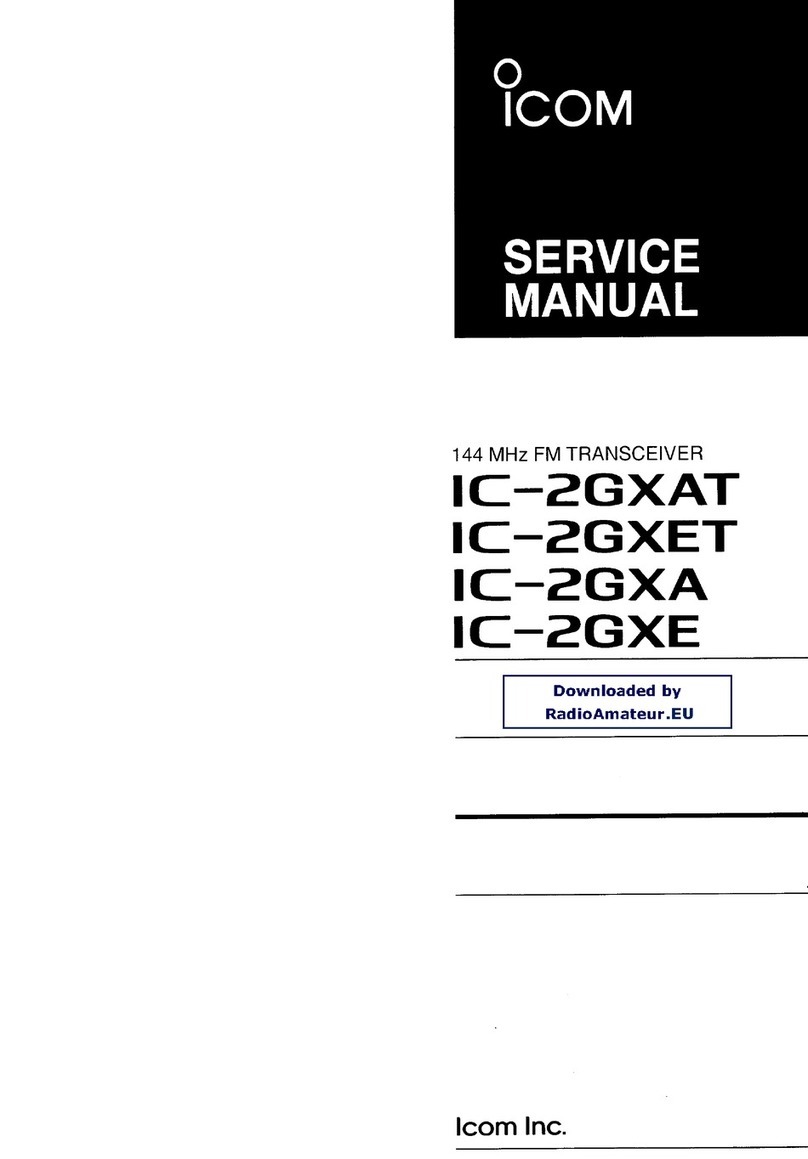
Icom
Icom IC-2GXAT User manual
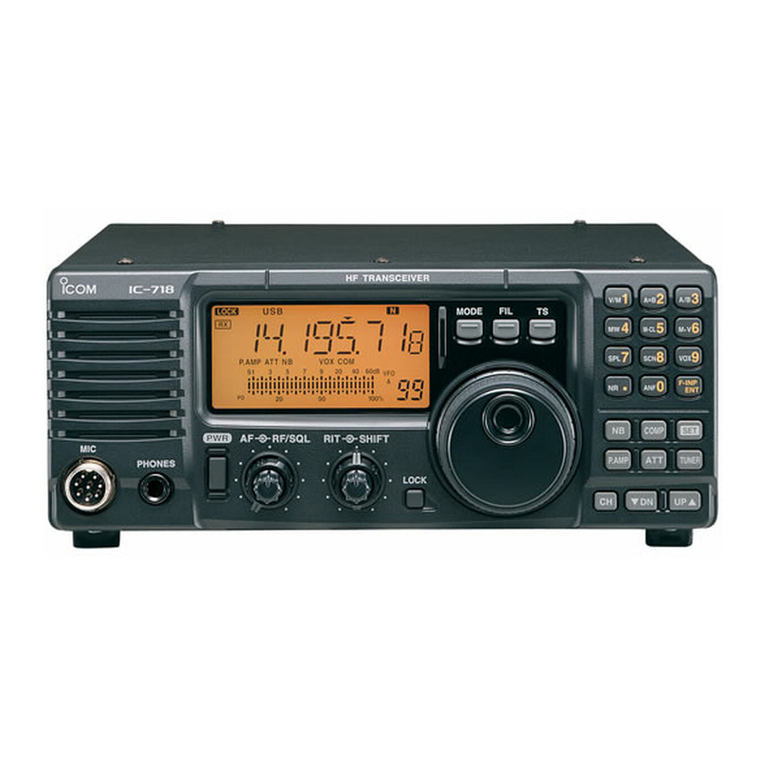
Icom
Icom IC-718 User manual
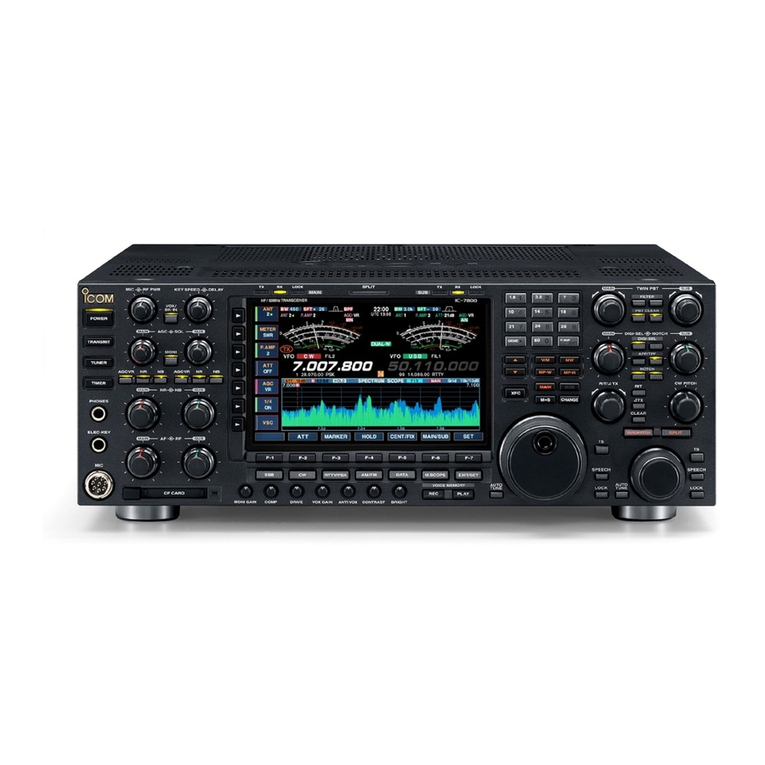
Icom
Icom IC-7800 User manual
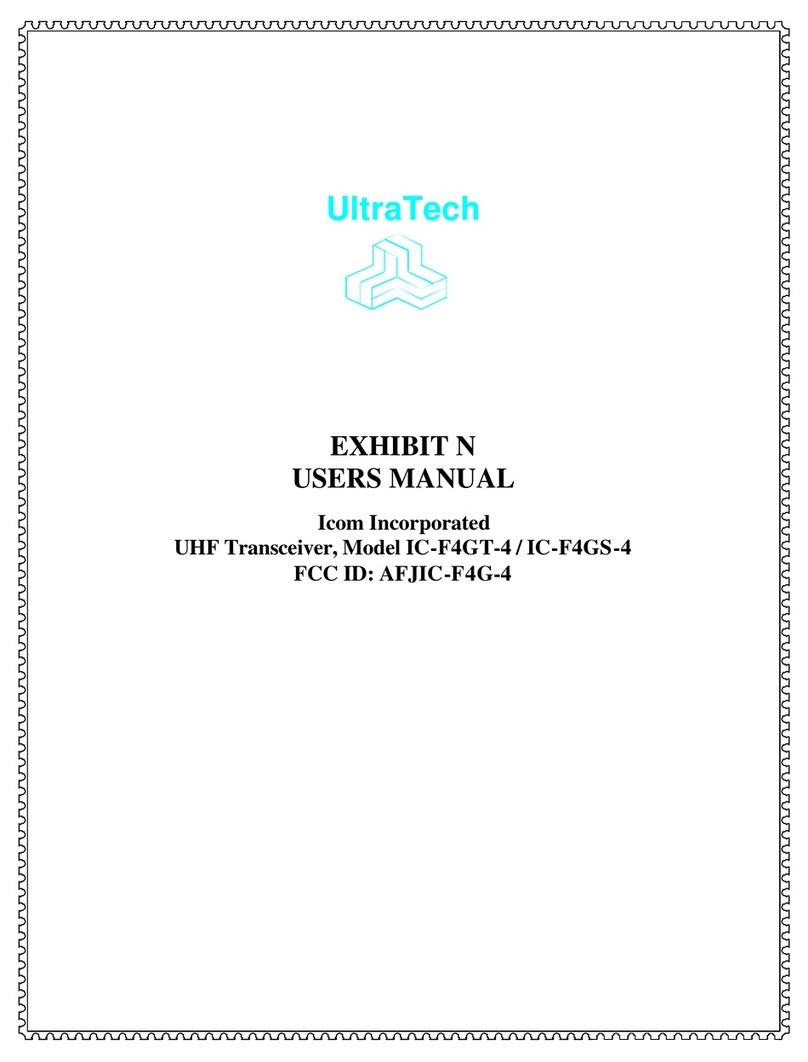
Icom
Icom UltraTech IC-F4GT-4 User manual
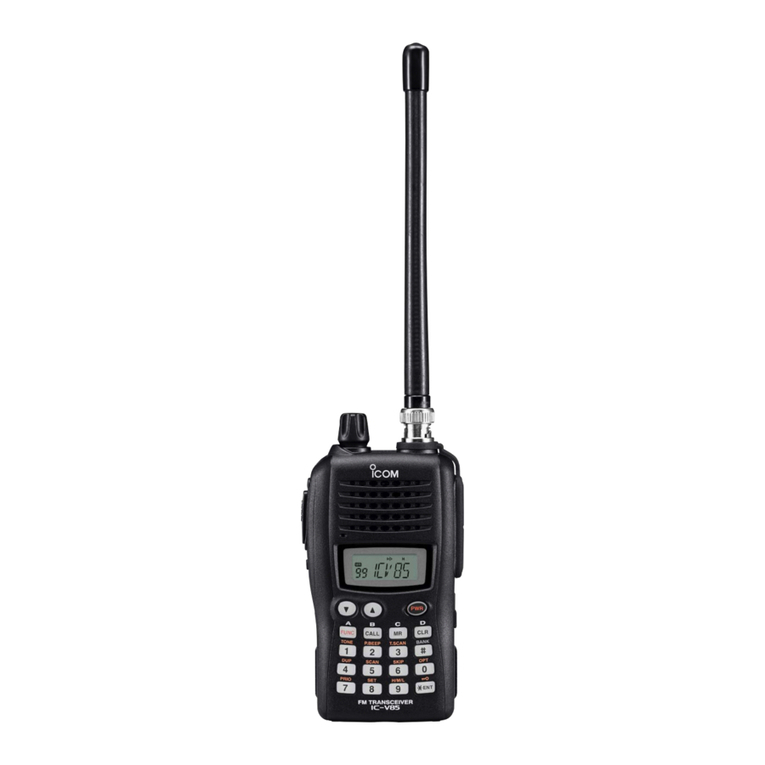
Icom
Icom IC-V85 User manual
Popular Transceiver manuals by other brands
Uniden
Uniden BearTracker 885 owner's manual
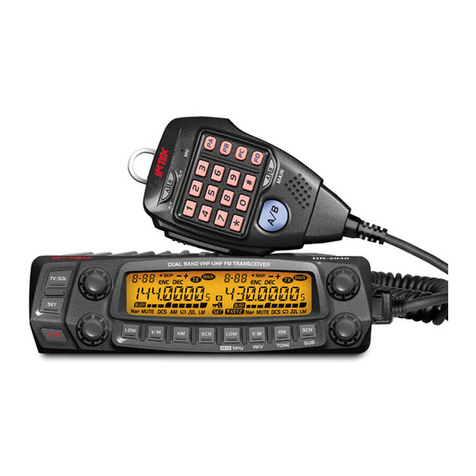
Intek
Intek HR-2040 owner's manual
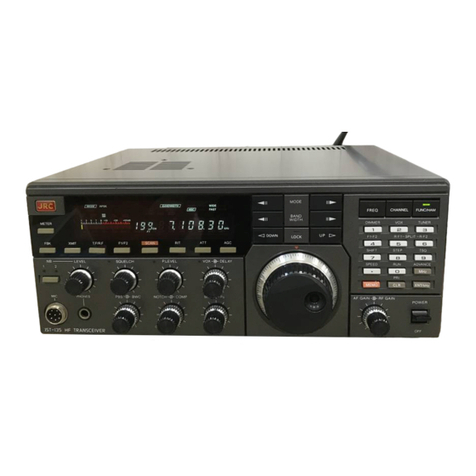
JRC
JRC JST-135 instruction manual

Verterx Standard
Verterx Standard VXA-300 Pilot III operating manual
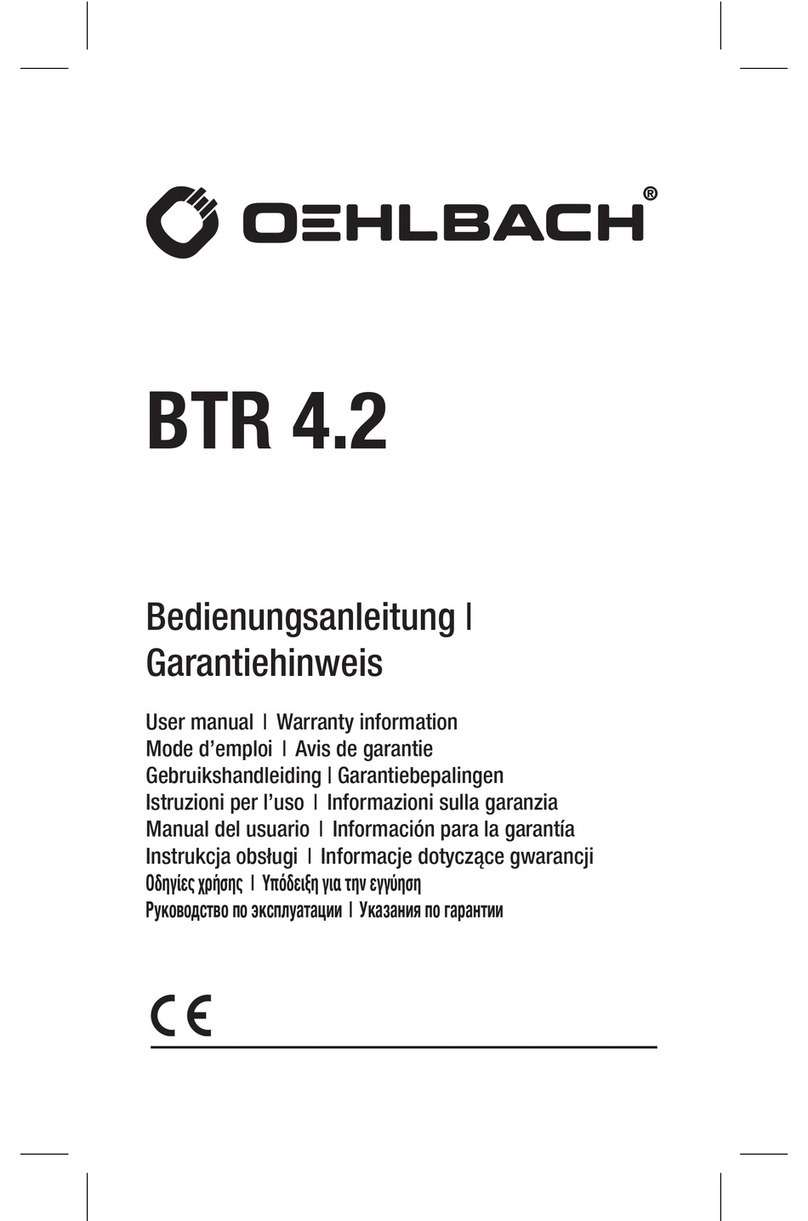
Oehlbach
Oehlbach BTR 4.2 user manual
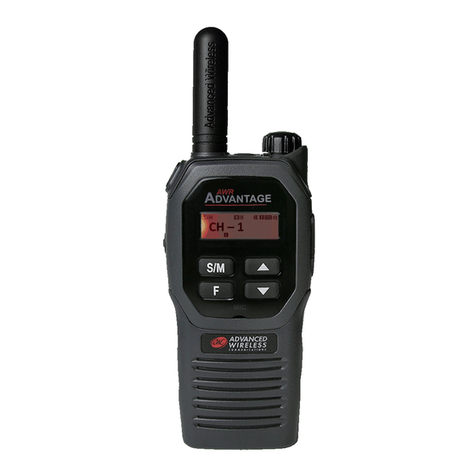
Advanced Wireless Communications
Advanced Wireless Communications AWR Advantage quick start guide
